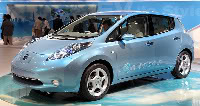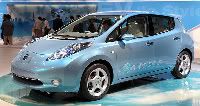Thoughts on the EV Adoption Curve


1) What does Big Auto think (or, at least, claim that they think) about EV production rates? Considering there are 230 million cars on the road in the US alone, the needle will not be moving in the short-term:
Nissan: Has pre-orders for 56,000 LEAF all-electric cars.
GM: Last year, had 50,000 expressions of interest in the Chevy Volt, though presumably that figure is somewhat larger now.
Mitsubishi: Bumped up its 2011 production schedule of the i-MiEV from 8,500 units to 9,000.
Better Place: Placed an order with Renault for 100,000 electric vehicles based on the Fluence ZE for its deal with Israel.
2) But is there any reason to believe anything coming out of Detroit?
Today, the population of Detroit is about half of what it was in 1950. The city has 33,500 empty homes and 91,000 vacant lots. A recent AP article asserts that vacant property totals 40 square miles. But Big Auto is not at all apologetic for the meltdown, and points out they couldn’t have foreseen the dynamics of oil prices that created sharp inflection points in the demand for fuel-efficient vehicles in favor of the Hummer and other gas-guzzlers. If this is false, they’re disingenuous; if it’s true, they’re incredibly obtuse. Either way, it’s hard to trust what they’re saying.
One thing for sure: there is nothing good in EVs for the big OEMs. They are happy to drag this transition out for decades, selling gas- and diesel-based cars and trucks as long as possible.
3) The Department of Energy apparently is not bullish on pure (battery) EVs.
Check out this report on the future of the automobile. Although the author sees lots of hybrids in our future, he really doesn’t see any pure EVs. Remarkable. I have to think this is simply a mistake.
4) Industry analysts are hedging their bets.
As reported in EV World, Accenture recently performed a survey that showed that six out of 10 consumers are more likely to buy a hybrid or electric vehicle “only when it is superior to gasoline-only models in every way.”
I understand that merely “being green” isn’t good enough for the vast majority of car buyers. But this report strikes me as the usual MBA malarky — a consultant who reads your watch and then tells you what time it is. What about the other 40%? Isn’t that a substantial market? And what exactly does “superior in every way” mean, exactly? How will the typical consumer react to a value proposition that includes dramatically lower fuel cost and huge reductions of other pieces of his total cost of ownership?
My belief: Give me a freeway-speed battery EV with comparable fit and finish to a garden-variety 5-passenger sedan, a 75-mile range, and price tag under $25,000 after rebate, and you won’t be able to manufacture enough of them.

I have all studies and also a patent applied for your under $25K highway-legal 5 passenger sedan. Find me a Warren Buffet to back me up and you’ll have it running from N.Y. to L.A. swapping packs on the way in a couple of seconds, or zipping non-stop on auto-pilot on a DualMode highway. For more info. write to Roberto dpaschoal@netzero.net P.S. It has also a list of 22 other advantages over anything else on the streets or drawing boards.
The above mentioned concept EV could cost under $15K after govt. rebates with advanced lead-acid batteries and 70mi. range, with the option to upgrade them whenever you want.